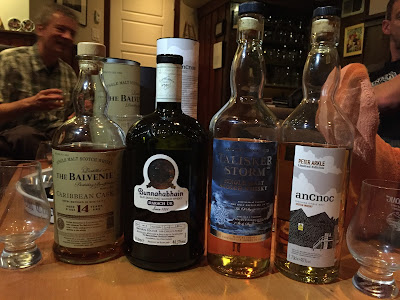 The idea that whisky is medicine is ancient and pervasive, but it struggles to rise above nudging and winking cliche and enter serious conversation. I too chuckled at the notion and dismissed it as a historical curiosity, much like the tinctures of opium favoured by Victorian matrons, until I read a book about the interaction between flavour, plant compounds and health ("The Dorito Effect" by Mark Schatzker - highly recommended). This got me thinking about the incredible array of flavours in whisky and the concentration effect of distillation. Do some of these flavours signal the presence of plant compounds that could have health benefits? Last Wednesday evening The Cabinet met to examine this question, so read on ...
The idea that whisky is medicine is ancient and pervasive, but it struggles to rise above nudging and winking cliche and enter serious conversation. I too chuckled at the notion and dismissed it as a historical curiosity, much like the tinctures of opium favoured by Victorian matrons, until I read a book about the interaction between flavour, plant compounds and health ("The Dorito Effect" by Mark Schatzker - highly recommended). This got me thinking about the incredible array of flavours in whisky and the concentration effect of distillation. Do some of these flavours signal the presence of plant compounds that could have health benefits? Last Wednesday evening The Cabinet met to examine this question, so read on ...For the bulk of the scientific content, such as it is, of this discussion I need to give credit to a mysterious Dr. Bunsen and his 2011 blog post "What's Inside Scotch Whisky":
http://www.drbunsen.org/whats-inside-scotch-whisky/
Where possible I corroborated and expanded on his statements by thumbing (virtually speaking) through the available literature.
On to the medicine then! Our first selection was the AnCnoc "Peter Arkle Limited Edition - Warehouse". Yes, as the industry moves away from simple age statements the names are doomed to become more and more elaborate and obscure. We all assumed that Peter Arkle is the master distiller, but in fact it turns out that he is a Scottish illustrator who has designed AnCnoc's labels and cylinders. And a handsome design it is. Here are the AnCnoc designs:
http://ancnoc.com/whiskies/peter-arkle/
And here is Mr. Arkle's own site:
http://peterarkle.com/
But I digress. Art and science are ever intertwined. And here is the full-on science: AnCnoc is known for having especially high levels of cis-3-methyl-4-octanolide. Bet you didn't know that. Further more, I bet you didn't know that cis-3-methyl-4-octanolide is a whisky lactone and that these lactones have numerous medicinal properties, notably including as antimicrobials. Lactones will impart a sweet flavour to the whisky and apparently roasted coconut notes as well. None of us were able to identify the latter, but the sweetness was certainly there. Beyond that we are sorry to report that it is a very simple whisky - a lot of fire up front, that sweetness and malt and then not much else. It is "fine". Fine enough to rate a 5.3 score, or "Two Drams = Fair" (Recommended With Reservation, Don't Seek Out, But Don't Necessarily Avoid).
 Next in line was the Bunnahbhain Darach Ur. Attentive readers will note that we had just tasted it at the last meeting, but we failed to rate it then, and it is Dr. Bunsen's pick for acetovanillone content. As you might anticipate, this is a vanilla flavour, but as you might not have anticipated, the vanilla analogue in this case does not come from the usual oak, but rather as one of the thousands of compounds extracted from peat. And you thought peat was just iodine and sulfur. What does acetovanillone do for us? It is proven to be a good anti-inflammatory. One of our members had recently injured his back and reported feeling better almost immediately upon drinking the Bunnahbhain. There may have been non-pharmacological reasons for this though as it scored a very respectable 6.8, "Three Drams = Good" (Recommended, Must Try). A more detailed description is available in two previous posts.
Next in line was the Bunnahbhain Darach Ur. Attentive readers will note that we had just tasted it at the last meeting, but we failed to rate it then, and it is Dr. Bunsen's pick for acetovanillone content. As you might anticipate, this is a vanilla flavour, but as you might not have anticipated, the vanilla analogue in this case does not come from the usual oak, but rather as one of the thousands of compounds extracted from peat. And you thought peat was just iodine and sulfur. What does acetovanillone do for us? It is proven to be a good anti-inflammatory. One of our members had recently injured his back and reported feeling better almost immediately upon drinking the Bunnahbhain. There may have been non-pharmacological reasons for this though as it scored a very respectable 6.8, "Three Drams = Good" (Recommended, Must Try). A more detailed description is available in two previous posts.Our third whisky was the Balvenie "Caribbean Cask" 14 year old. The 12 year old "Double Wood" had previously scored well in the Three Dram range, so we were optimistic about this one and, moreover, excited by it's ellagic acid content. Ellagic acid is under serious study as an anti-cancer agent, especially respecting prostate cancer (a welcome irony given the demographic of the average scotch whisky enthusiast). It is in part responsible for the current fuss surrounding pomegranate juice. But we would rather drink whisky. Even this whisky which was disappointingly dull. Ellagic acid can be detected as astringency and that was present, so all our prostates settled down, but outside of that it was smothered by the long cask finish which put a dull, vaguely sweet, vaguely toffee-ish blanket across the palate. Other review sites rave about it. We scored it 4.3 or "Two Drams", like the AnCnoc.
And then finally the star of the evening. (That was foreshadowing.) It was with a great deal of trepidation that I selected a bottle of Talisker "Storm" for this evening. Don't get me wrong, Talisker is a true classic, but their forays into marketing department driven branding make The Cabinet nervous. Storm? What does that actually mean in a whisky context? Only rainwater collected in winter gales used? Distillery now placed on a herring trawler? Fie. But no matter. We decided that the poor master distiller had this name forced upon a product that he still created with the same care, attention and craftsmanship as its more sensibly named predecessors. And we were right. Here was balance. Here was complexity. Here was the sea and the land and the peat and the wood and everything we love about scotch whisky. 7.7; high up in the Three Drams range. And oh, the medicinal effect? Talisker is well known for its ortho-cresol content. Ortho-cresol as in creosote. As in coal tar. Toxic, corrosive, kind of nasty and oh so tasty. And quite the opposite of healthy. We just had to cap the evening by being contrary.
Slainte!


No comments:
Post a Comment